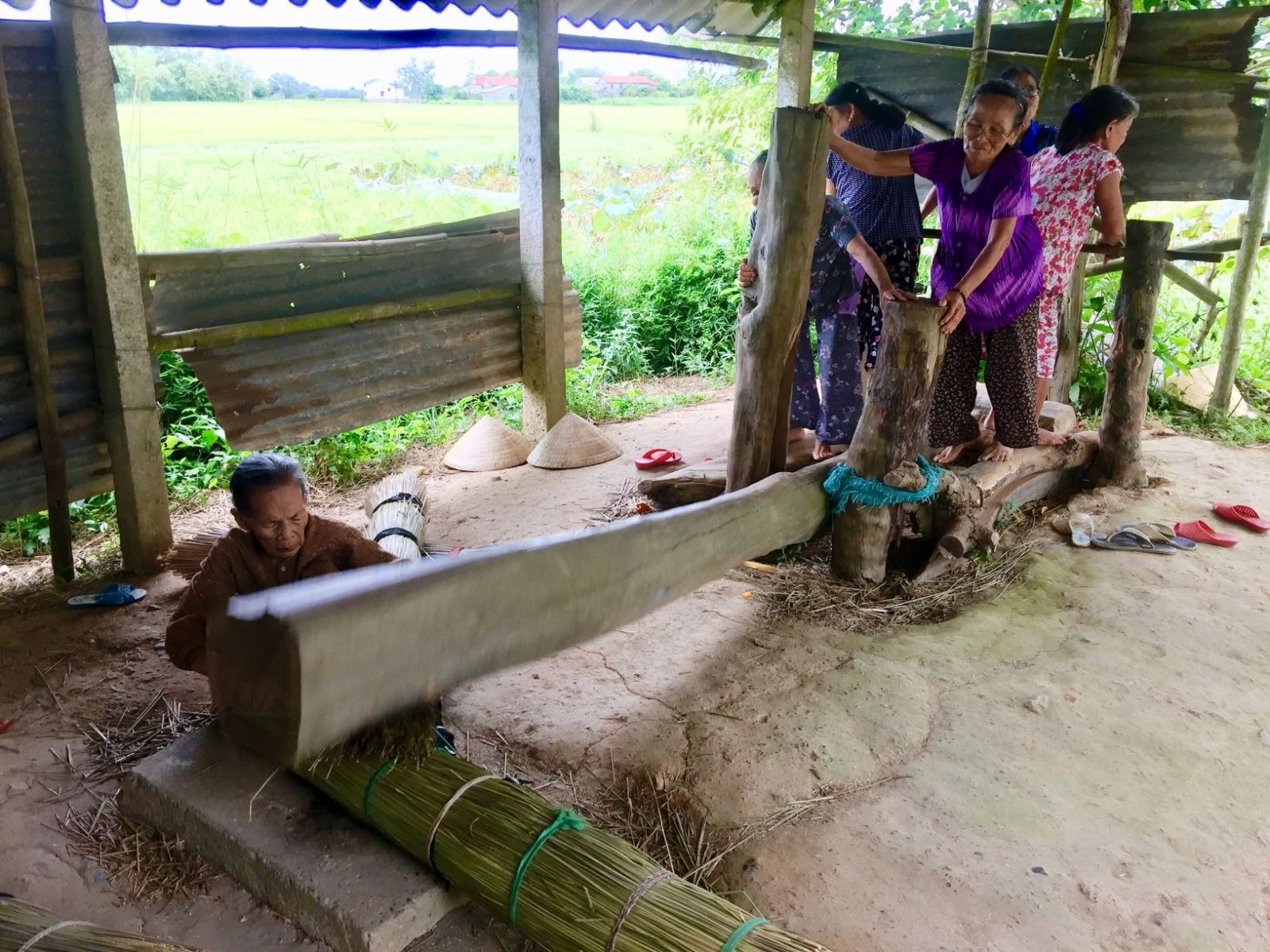Keeping the essence
In Phong Binh commune (Phong Dien district) lie two famous craft villages, known as Bang-tree-mattress-making village of Pho Trach and net-weaving village of Van Trinh, which date back to hundreds of years.
According to the cultural researcher Nguyen The, despite having reduced in prosperity compared to the past, thanks to the characteristics of Bang tree (Terminalia catappa) – the main material used in the making of mattresses, together with the unique traditional weaving style, the Bang mattress crafting of Pho Trach is still maintained, which helps preserve the long-lasting cultural features of Pho Trach people. Being moist- resistant in winter and airy in summer, the products made from Bang fiber are at an advantage over many others on the market.

The people of Phong Binh commune pounding the bark of Bang tree for fiber. Photo: Le Tho
For craft villages in Phong Binh to "survive" and thrive, besides making traditional products, the people here have taken steps to diversify their designs. In addition to Bang mattresses, the locals also knit floor cushions, stylish handbags, trays, rubbish bins, decorative lamps, etc. As for net weaving, the people have acquired mass production using machines. “Conventional crafts can provide jobs for hundreds of people in the region as well as preserving cultural features of the past. Therefore, maintaining craft villages means protecting the culture of a whole area. Currently, the production output is quite stable, so these traditional trades are sustained and developed” said Mr. Nguyen Ngoc Khanh, chairman of the People’s Committee of Phong Binh district.
The Zèng weaving (brocade-making) practice of A Luoi was acknowledged as an intangible cultural heritage of the nation in 2017 by the Ministry of Culture and Information and it is also one of the 13 craft villages listed as in need of preservation.
According to artisan Mai Thi Hop (of A Luoi town), the Ta Oi people regard Zèng as the soul of their village so this practice is maintained and passed down through many generations. Still based on traditional Ta Oi's materials and patterns, alterations and adaptations have been made to the practice in order to meet current market demands.
Besides the survival of many of the craft villages, a considerable number of others are vanishing due to various reasons, including the failure to meet market demands, a lack of resources, a deficiency of craftsmen,… to name a few.
Traditional craft villages should be closely linked with development
| In the province, there are a total of 40 craft villages, traditional craft villages and traditional crafts having been acknowledged. Among them, 13 typical craft villages that need long-term preservation include pottery-making village of Phuoc Tich, Bang-mattress-crafting of Pho Trach, forging village of Hien Luong, folk paintings village of Sinh, conical hat making village of My Lam, paper-flower-making village of Thanh Tien, conical hat making village of Thanh Tan, conical hat making village of Van The, Zeng weaving village of A Dot, Zeng weaving village of A Hua, Zeng weaving village of A Roang commune, Zeng weaving village of A Luoi town and Zeng weaving village of A Ngo commune. |
According to People’s Committee of Thua Thien Hue Province, in order to preserve and develop traditional craft villages which are on the verge of disappearance, the local authorities need to set up development projects for these traditional villages in close connection with tourism; building plans for resources areas; applying production showcase model including serving the tourists, providing vocational training, building showrooms and introducing traditional products to tourists. Besides, they should innovate and develop touristy products, invest in building infrastructure to preserve and enhance traditional craft villages which are closely linked to tourism. Also, creating some specific tourist routes for visiting traditional craft villages and historical, local sites is another suggestion.
In reality, in the process of including some traditional craft villages into planning projects toward 2020, with a view to 2025, some traditional craft villages were chosen to participate in many activities related to tourism. Some of the examples are copper casting village (Phuong Duc Ward, Hue City); Phuoc Tich pottery village and My Xuyen wood engraving village (Phong Hoa Commune, Phong Dien District); Sinh village’s traditional folk paintings and Thanh Tien paper flower craft villages (Phu Mau Commune, Phu Vang District); “Zèng” weaving village at A Roang and A Dot Communes, A Luoi Town (A Luoi District); Bao La bamboo and rattan weaving village (Quang Phu Commune and Thuy Lap Hamlet, Quang Loi Commune, Quang Dien District), etc.
The local authorities have also embarked on creating production supply areas to preserve traditional craft villages. “As for Phuoc Tich pottery, two communes - Phong Hoa and Phong Binh will be in charge of doing a survey on the quantity of clay resources and making plans for it. With respect to Pho Trach’s mattress made from Bang trees (Terminalia catappa), the area for planting the trees are also put into planning” Mr. Nguyen Van Binh, Vice Chairman of Phong Dien District People’s Committee said.
Mr. Tran Duc, Vice Chairman of the Rural Development Department remarked, “Nowadays, a lot of traditional craft villages are developing stably, for instance, Thanh Lam broom making traditional village (from Thysanolaena Latifolia trees), bamboo toothpick making village of Thuy Bang Commune, or Bao La weaving village. However, some craft villages are just getting by, such as some villages processing seafood due to the factors of input and scale. What is most important now is that we must preserve our cultural traditions and enhance our skills and strengths. For example, one of the biggest strengths of copper casting in Hue is that our bells and statues are of large size. Furthermore, although the Northern villages make delicate products from rattan, when it comes to products made from bamboo, none of them can be compared to those of Bao La village.
Story and photo: Le Tho